Case Study- Training and Apprenticeship program for high school Students
VerifiedAdded on 2023/04/21
|23
|3813
|352
AI Summary
This case study focuses on a training and apprenticeship program for high school students organized by Globlex. The program aims to enhance farmland productivity and provide job opportunities to students. The report covers project management, scope, work breakdown structure, risk analysis, and more.
Contribute Materials
Your contribution can guide someone’s learning journey. Share your
documents today.
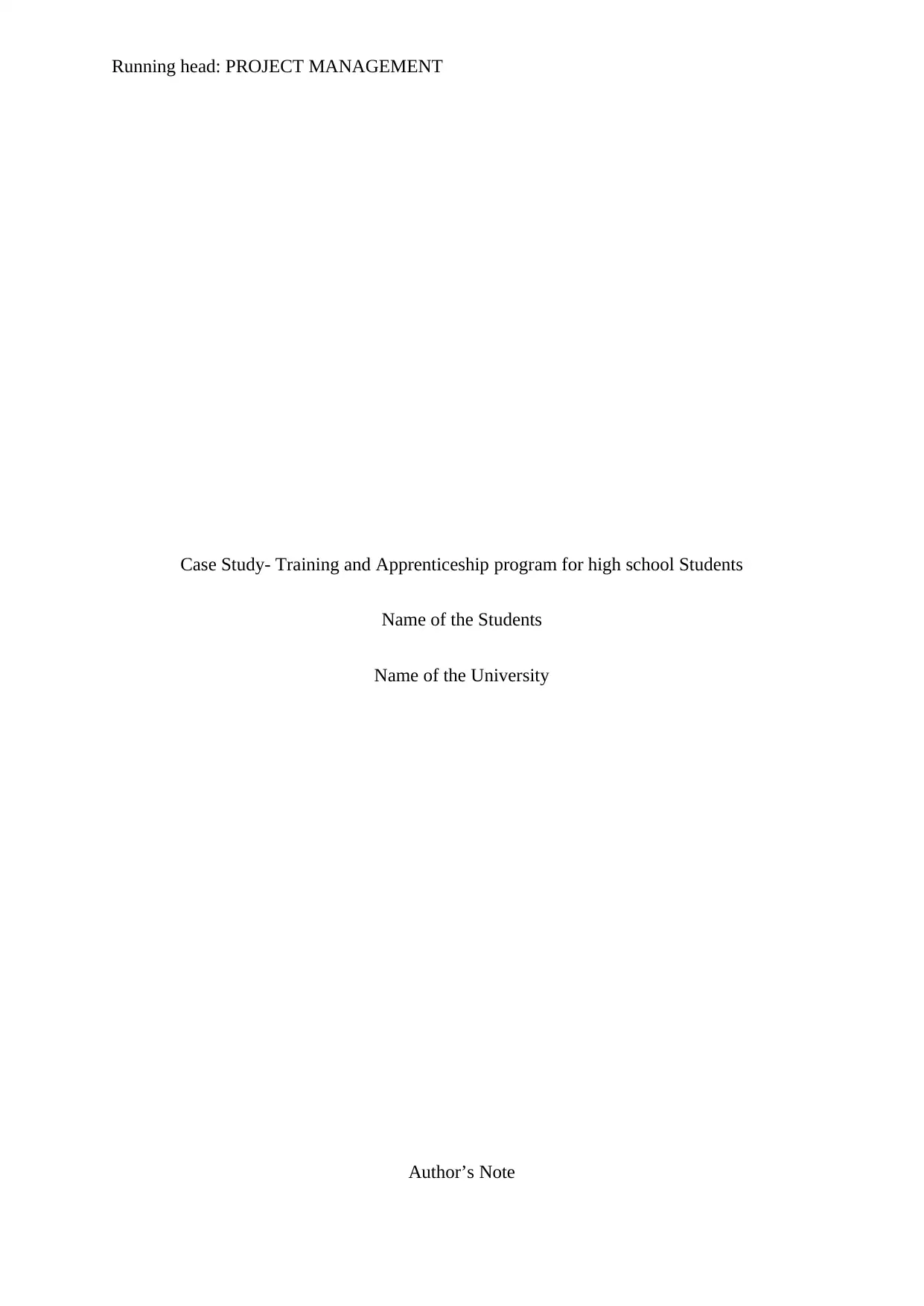
Running head: PROJECT MANAGEMENT
Case Study- Training and Apprenticeship program for high school Students
Name of the Students
Name of the University
Author’s Note
Case Study- Training and Apprenticeship program for high school Students
Name of the Students
Name of the University
Author’s Note
Secure Best Marks with AI Grader
Need help grading? Try our AI Grader for instant feedback on your assignments.
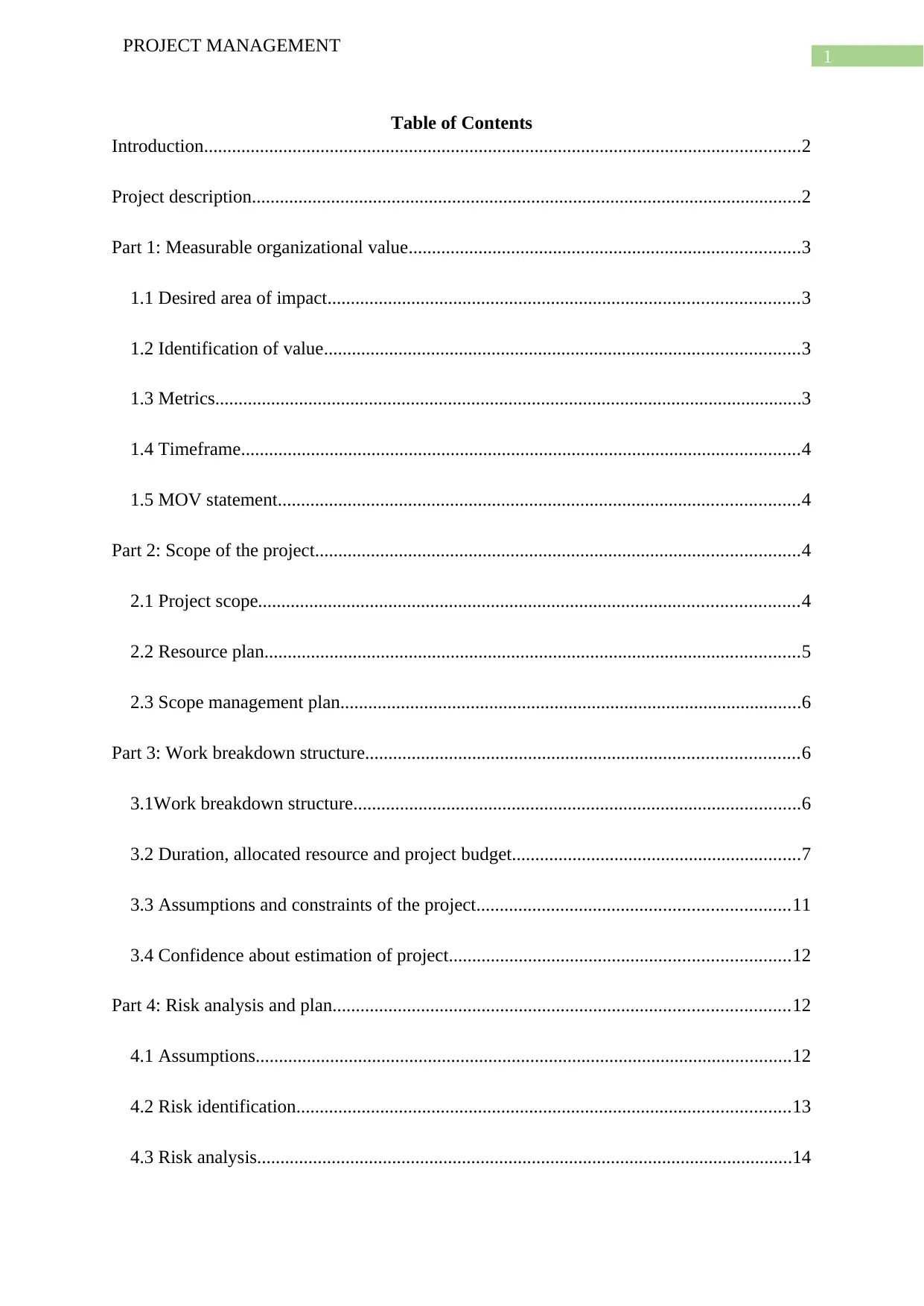
1
PROJECT MANAGEMENT
Table of Contents
Introduction................................................................................................................................2
Project description......................................................................................................................2
Part 1: Measurable organizational value....................................................................................3
1.1 Desired area of impact.....................................................................................................3
1.2 Identification of value......................................................................................................3
1.3 Metrics..............................................................................................................................3
1.4 Timeframe........................................................................................................................4
1.5 MOV statement................................................................................................................4
Part 2: Scope of the project........................................................................................................4
2.1 Project scope....................................................................................................................4
2.2 Resource plan...................................................................................................................5
2.3 Scope management plan...................................................................................................6
Part 3: Work breakdown structure.............................................................................................6
3.1Work breakdown structure................................................................................................6
3.2 Duration, allocated resource and project budget..............................................................7
3.3 Assumptions and constraints of the project...................................................................11
3.4 Confidence about estimation of project.........................................................................12
Part 4: Risk analysis and plan..................................................................................................12
4.1 Assumptions...................................................................................................................12
4.2 Risk identification..........................................................................................................13
4.3 Risk analysis...................................................................................................................14
PROJECT MANAGEMENT
Table of Contents
Introduction................................................................................................................................2
Project description......................................................................................................................2
Part 1: Measurable organizational value....................................................................................3
1.1 Desired area of impact.....................................................................................................3
1.2 Identification of value......................................................................................................3
1.3 Metrics..............................................................................................................................3
1.4 Timeframe........................................................................................................................4
1.5 MOV statement................................................................................................................4
Part 2: Scope of the project........................................................................................................4
2.1 Project scope....................................................................................................................4
2.2 Resource plan...................................................................................................................5
2.3 Scope management plan...................................................................................................6
Part 3: Work breakdown structure.............................................................................................6
3.1Work breakdown structure................................................................................................6
3.2 Duration, allocated resource and project budget..............................................................7
3.3 Assumptions and constraints of the project...................................................................11
3.4 Confidence about estimation of project.........................................................................12
Part 4: Risk analysis and plan..................................................................................................12
4.1 Assumptions...................................................................................................................12
4.2 Risk identification..........................................................................................................13
4.3 Risk analysis...................................................................................................................14
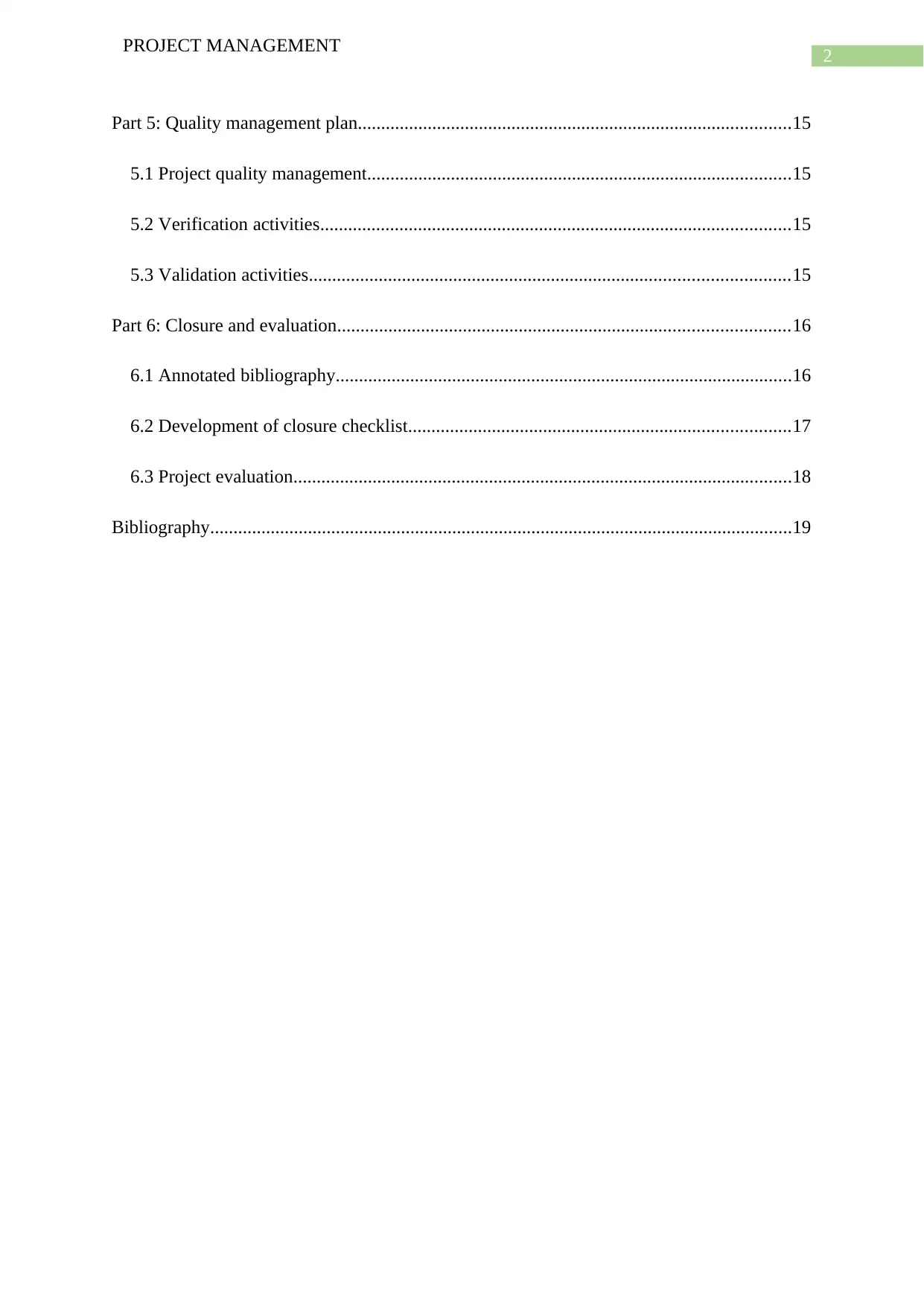
2
PROJECT MANAGEMENT
Part 5: Quality management plan.............................................................................................15
5.1 Project quality management...........................................................................................15
5.2 Verification activities.....................................................................................................15
5.3 Validation activities.......................................................................................................15
Part 6: Closure and evaluation.................................................................................................16
6.1 Annotated bibliography..................................................................................................16
6.2 Development of closure checklist..................................................................................17
6.3 Project evaluation...........................................................................................................18
Bibliography.............................................................................................................................19
PROJECT MANAGEMENT
Part 5: Quality management plan.............................................................................................15
5.1 Project quality management...........................................................................................15
5.2 Verification activities.....................................................................................................15
5.3 Validation activities.......................................................................................................15
Part 6: Closure and evaluation.................................................................................................16
6.1 Annotated bibliography..................................................................................................16
6.2 Development of closure checklist..................................................................................17
6.3 Project evaluation...........................................................................................................18
Bibliography.............................................................................................................................19
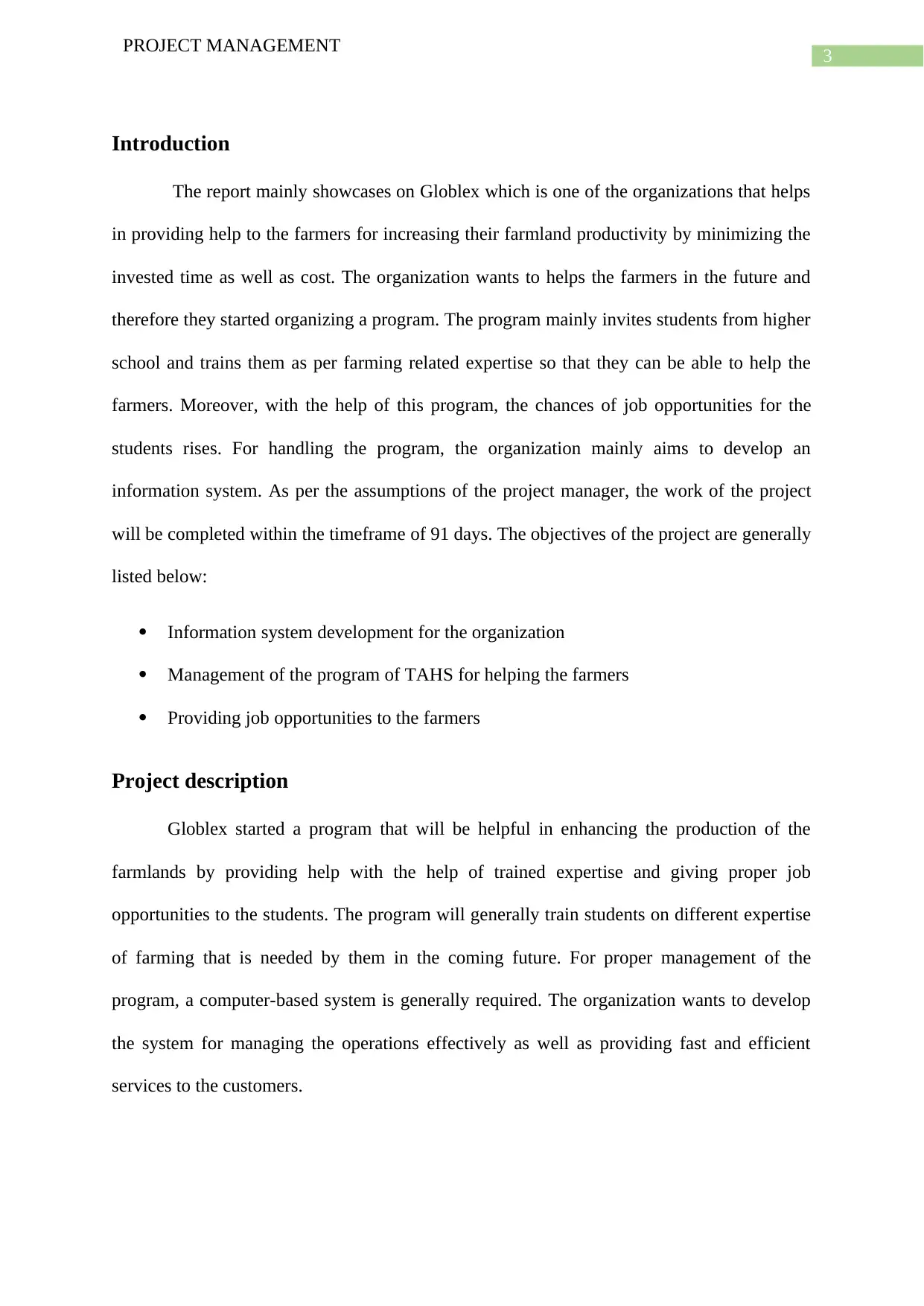
3
PROJECT MANAGEMENT
Introduction
The report mainly showcases on Globlex which is one of the organizations that helps
in providing help to the farmers for increasing their farmland productivity by minimizing the
invested time as well as cost. The organization wants to helps the farmers in the future and
therefore they started organizing a program. The program mainly invites students from higher
school and trains them as per farming related expertise so that they can be able to help the
farmers. Moreover, with the help of this program, the chances of job opportunities for the
students rises. For handling the program, the organization mainly aims to develop an
information system. As per the assumptions of the project manager, the work of the project
will be completed within the timeframe of 91 days. The objectives of the project are generally
listed below:
Information system development for the organization
Management of the program of TAHS for helping the farmers
Providing job opportunities to the farmers
Project description
Globlex started a program that will be helpful in enhancing the production of the
farmlands by providing help with the help of trained expertise and giving proper job
opportunities to the students. The program will generally train students on different expertise
of farming that is needed by them in the coming future. For proper management of the
program, a computer-based system is generally required. The organization wants to develop
the system for managing the operations effectively as well as providing fast and efficient
services to the customers.
PROJECT MANAGEMENT
Introduction
The report mainly showcases on Globlex which is one of the organizations that helps
in providing help to the farmers for increasing their farmland productivity by minimizing the
invested time as well as cost. The organization wants to helps the farmers in the future and
therefore they started organizing a program. The program mainly invites students from higher
school and trains them as per farming related expertise so that they can be able to help the
farmers. Moreover, with the help of this program, the chances of job opportunities for the
students rises. For handling the program, the organization mainly aims to develop an
information system. As per the assumptions of the project manager, the work of the project
will be completed within the timeframe of 91 days. The objectives of the project are generally
listed below:
Information system development for the organization
Management of the program of TAHS for helping the farmers
Providing job opportunities to the farmers
Project description
Globlex started a program that will be helpful in enhancing the production of the
farmlands by providing help with the help of trained expertise and giving proper job
opportunities to the students. The program will generally train students on different expertise
of farming that is needed by them in the coming future. For proper management of the
program, a computer-based system is generally required. The organization wants to develop
the system for managing the operations effectively as well as providing fast and efficient
services to the customers.
Secure Best Marks with AI Grader
Need help grading? Try our AI Grader for instant feedback on your assignments.

4
PROJECT MANAGEMENT
Part 1: Measurable organizational value
1.1 Desired area of impact
The area of impact for the project are mainly highlighted in the table below:
Factor Rank
Operational 1st
Customer 2nd
Financial 3rd
Social 4th
Strategy 5th
1.2 Identification of value
The value that is provided by the new information system are generally illustrated
below:
Better: Efficient as well as better services are provided by the new system in
comparison to the system that was used earlier for managing the operation of the
organization.
Faster: The new information system helps the organization to reach to the customers
quite easily and therefore they can fulfill the demands of the customers quite effectively.
1.3 Metrics
Factor Metrics
Operational The operation of the program gets improved
by 13%.
Customer 15% rise in the number of customers are
PROJECT MANAGEMENT
Part 1: Measurable organizational value
1.1 Desired area of impact
The area of impact for the project are mainly highlighted in the table below:
Factor Rank
Operational 1st
Customer 2nd
Financial 3rd
Social 4th
Strategy 5th
1.2 Identification of value
The value that is provided by the new information system are generally illustrated
below:
Better: Efficient as well as better services are provided by the new system in
comparison to the system that was used earlier for managing the operation of the
organization.
Faster: The new information system helps the organization to reach to the customers
quite easily and therefore they can fulfill the demands of the customers quite effectively.
1.3 Metrics
Factor Metrics
Operational The operation of the program gets improved
by 13%.
Customer 15% rise in the number of customers are

5
PROJECT MANAGEMENT
reflected.
Financial 20% rise in the financial budget of the
project is needed.
Social 5% of the customers increases due to use of
social media.
Strategy Use of proper strategy helps in improving
the organization.
1.4 Timeframe
Factor Timeframe
Operational 2 months
Customer 3 months
Financial 3 months
Social 1month
Strategy 2 months
1.5 MOV statement
Measurable organizational value is mainly defined as an important goal of the project
which is generally used in order to illustrate the value that project generally brings to the
customers of the organization. For providing value to the organization, it is quite necessary to
properly align it with the mission and strategy of the organization.
Part 2: Scope of the project
2.1 Project scope
The scope of the project is mainly reflected below:
Development of information system for the organization
Providing tracking and reporting facility
PROJECT MANAGEMENT
reflected.
Financial 20% rise in the financial budget of the
project is needed.
Social 5% of the customers increases due to use of
social media.
Strategy Use of proper strategy helps in improving
the organization.
1.4 Timeframe
Factor Timeframe
Operational 2 months
Customer 3 months
Financial 3 months
Social 1month
Strategy 2 months
1.5 MOV statement
Measurable organizational value is mainly defined as an important goal of the project
which is generally used in order to illustrate the value that project generally brings to the
customers of the organization. For providing value to the organization, it is quite necessary to
properly align it with the mission and strategy of the organization.
Part 2: Scope of the project
2.1 Project scope
The scope of the project is mainly reflected below:
Development of information system for the organization
Providing tracking and reporting facility

6
PROJECT MANAGEMENT
To give invitation to the students
To provide training facility to the higher school students
Providing help to the farmers in increasing productivity
2.2 Resource plan
Human resource: The human resources who are associated with the information
system development are listed below:
Figure 1: Human resource
(Source: Created by Author)
Technology: The needed technologies mainly include:
Software: Development tools and designing tools
Hardware: CPU, Hard disk, desktop
Facility: Travelling allowances are provided to the project team for working
additional hours.
PROJECT MANAGEMENT
To give invitation to the students
To provide training facility to the higher school students
Providing help to the farmers in increasing productivity
2.2 Resource plan
Human resource: The human resources who are associated with the information
system development are listed below:
Figure 1: Human resource
(Source: Created by Author)
Technology: The needed technologies mainly include:
Software: Development tools and designing tools
Hardware: CPU, Hard disk, desktop
Facility: Travelling allowances are provided to the project team for working
additional hours.
Paraphrase This Document
Need a fresh take? Get an instant paraphrase of this document with our AI Paraphraser

7
PROJECT MANAGEMENT
Others: Workshop facility should be given to the team so that the project team can
gain knowledge about the project.
2.3 Scope management plan
Scope management is defined as one of the procedures that helps in elaborating the
work tat is generally needed and then it ensures that all the work that are related with the
project will be completed on time. The scope management plan must include proper detailed
procedure about the determination of the scope, its management as well as control. The steps
which are given below helps in managing the project scope quite effectively.
The needs of the project should be determined effectively for ensuring that all the
needs of the project are met
Understanding about the objectives are important for meeting the project goals
Avoiding scope creep in the initial stage of the project is important for avoiding
challenges.
Part 3: Work breakdown structure
3.1Work breakdown structure
Development of
computer based
system.mpp
Project initiation phase
Undertaking survey
for gathering data
Gathering data
about project
Determining the
important data
Stkaeholders
identification
Project plan
Business plan
Charter
development
Milestone
1:Completion of
initiation phase
Project planning phase
Project resource
estimation
Duration estimation
Resource plan
estimation
Recruitment of team
members
Analyzing system
Project schedule
development
Project plan
Milestone
2:Completion of
planning phase
Project designing phase
Selection of proper
design
Development of
prototype
Design outline
Review of design
Milestone
3:Completion of the
design phase of the
project
Project development
phase
Project plan
development
Invitation to the
students
Facility of training
Adding ideas related
to student
Development of
database
Placement of
student
Tracking apprentice
Milestone 4:
Completion of
development phase
Closing phase
Providing manuals
for training purpose
Training fcaility to
the employees
Project review
Milestone
5:Completion of
closure phase
PROJECT MANAGEMENT
Others: Workshop facility should be given to the team so that the project team can
gain knowledge about the project.
2.3 Scope management plan
Scope management is defined as one of the procedures that helps in elaborating the
work tat is generally needed and then it ensures that all the work that are related with the
project will be completed on time. The scope management plan must include proper detailed
procedure about the determination of the scope, its management as well as control. The steps
which are given below helps in managing the project scope quite effectively.
The needs of the project should be determined effectively for ensuring that all the
needs of the project are met
Understanding about the objectives are important for meeting the project goals
Avoiding scope creep in the initial stage of the project is important for avoiding
challenges.
Part 3: Work breakdown structure
3.1Work breakdown structure
Development of
computer based
system.mpp
Project initiation phase
Undertaking survey
for gathering data
Gathering data
about project
Determining the
important data
Stkaeholders
identification
Project plan
Business plan
Charter
development
Milestone
1:Completion of
initiation phase
Project planning phase
Project resource
estimation
Duration estimation
Resource plan
estimation
Recruitment of team
members
Analyzing system
Project schedule
development
Project plan
Milestone
2:Completion of
planning phase
Project designing phase
Selection of proper
design
Development of
prototype
Design outline
Review of design
Milestone
3:Completion of the
design phase of the
project
Project development
phase
Project plan
development
Invitation to the
students
Facility of training
Adding ideas related
to student
Development of
database
Placement of
student
Tracking apprentice
Milestone 4:
Completion of
development phase
Closing phase
Providing manuals
for training purpose
Training fcaility to
the employees
Project review
Milestone
5:Completion of
closure phase
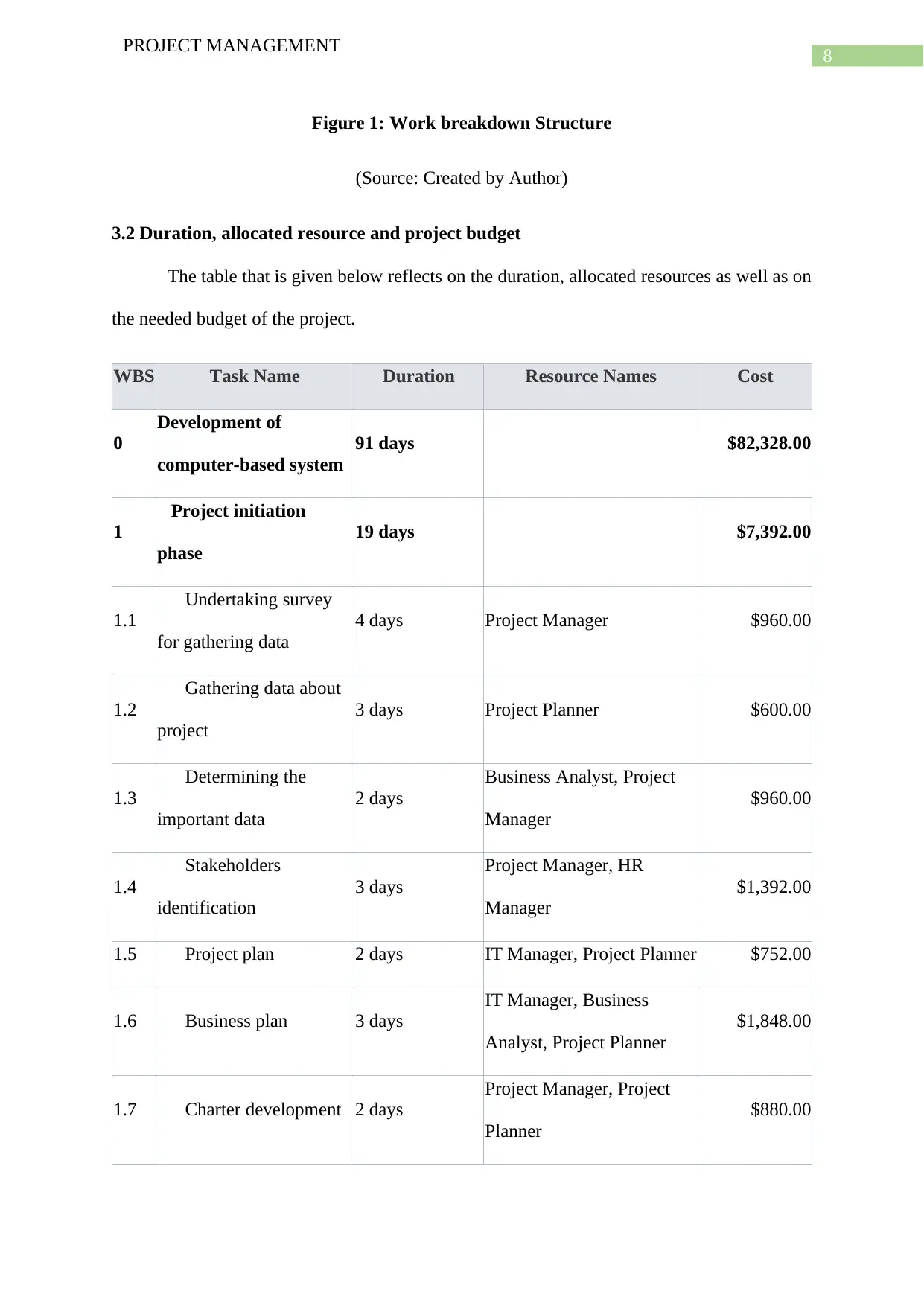
8
PROJECT MANAGEMENT
Figure 1: Work breakdown Structure
(Source: Created by Author)
3.2 Duration, allocated resource and project budget
The table that is given below reflects on the duration, allocated resources as well as on
the needed budget of the project.
WBS Task Name Duration Resource Names Cost
0
Development of
computer-based system
91 days $82,328.00
1
Project initiation
phase
19 days $7,392.00
1.1
Undertaking survey
for gathering data
4 days Project Manager $960.00
1.2
Gathering data about
project
3 days Project Planner $600.00
1.3
Determining the
important data
2 days
Business Analyst, Project
Manager
$960.00
1.4
Stakeholders
identification
3 days
Project Manager, HR
Manager
$1,392.00
1.5 Project plan 2 days IT Manager, Project Planner $752.00
1.6 Business plan 3 days
IT Manager, Business
Analyst, Project Planner
$1,848.00
1.7 Charter development 2 days
Project Manager, Project
Planner
$880.00
PROJECT MANAGEMENT
Figure 1: Work breakdown Structure
(Source: Created by Author)
3.2 Duration, allocated resource and project budget
The table that is given below reflects on the duration, allocated resources as well as on
the needed budget of the project.
WBS Task Name Duration Resource Names Cost
0
Development of
computer-based system
91 days $82,328.00
1
Project initiation
phase
19 days $7,392.00
1.1
Undertaking survey
for gathering data
4 days Project Manager $960.00
1.2
Gathering data about
project
3 days Project Planner $600.00
1.3
Determining the
important data
2 days
Business Analyst, Project
Manager
$960.00
1.4
Stakeholders
identification
3 days
Project Manager, HR
Manager
$1,392.00
1.5 Project plan 2 days IT Manager, Project Planner $752.00
1.6 Business plan 3 days
IT Manager, Business
Analyst, Project Planner
$1,848.00
1.7 Charter development 2 days
Project Manager, Project
Planner
$880.00

9
PROJECT MANAGEMENT
1.8
Milestone 1:
Completion of initiation
phase
0 days $0.00
2
Project planning
phase
22 days $8,000.00
2.1
Project resource
estimation
3 days
Financial Officer, HR
Manager, Project Sponsor
$1,872.00
2.2 Duration estimation 4 days Project Manager $960.00
2.3
Resource plan
estimation
3 days HR Manager $672.00
2.4
Recruitment of team
members
3 days HR Manager $672.00
2.5 Analyzing system 4 days
Designer, IT Consultant, IT
Manager
$2,304.00
2.6
Project schedule
development
2 days
IT Consultant, Project
Planner
$800.00
2.7 Project plan 3 days Project Manager $720.00
2.8
Milestone 2:
Completion of planning
phase
0 days
Project Manager, Project
Planner
$0.00
3
Project designing
phase
12 days $41,792.00
3.1
Selection of proper
design
4 days
Business Analyst, Designer,
Developer
$2,464.00
PROJECT MANAGEMENT
1.8
Milestone 1:
Completion of initiation
phase
0 days $0.00
2
Project planning
phase
22 days $8,000.00
2.1
Project resource
estimation
3 days
Financial Officer, HR
Manager, Project Sponsor
$1,872.00
2.2 Duration estimation 4 days Project Manager $960.00
2.3
Resource plan
estimation
3 days HR Manager $672.00
2.4
Recruitment of team
members
3 days HR Manager $672.00
2.5 Analyzing system 4 days
Designer, IT Consultant, IT
Manager
$2,304.00
2.6
Project schedule
development
2 days
IT Consultant, Project
Planner
$800.00
2.7 Project plan 3 days Project Manager $720.00
2.8
Milestone 2:
Completion of planning
phase
0 days
Project Manager, Project
Planner
$0.00
3
Project designing
phase
12 days $41,792.00
3.1
Selection of proper
design
4 days
Business Analyst, Designer,
Developer
$2,464.00
Secure Best Marks with AI Grader
Need help grading? Try our AI Grader for instant feedback on your assignments.
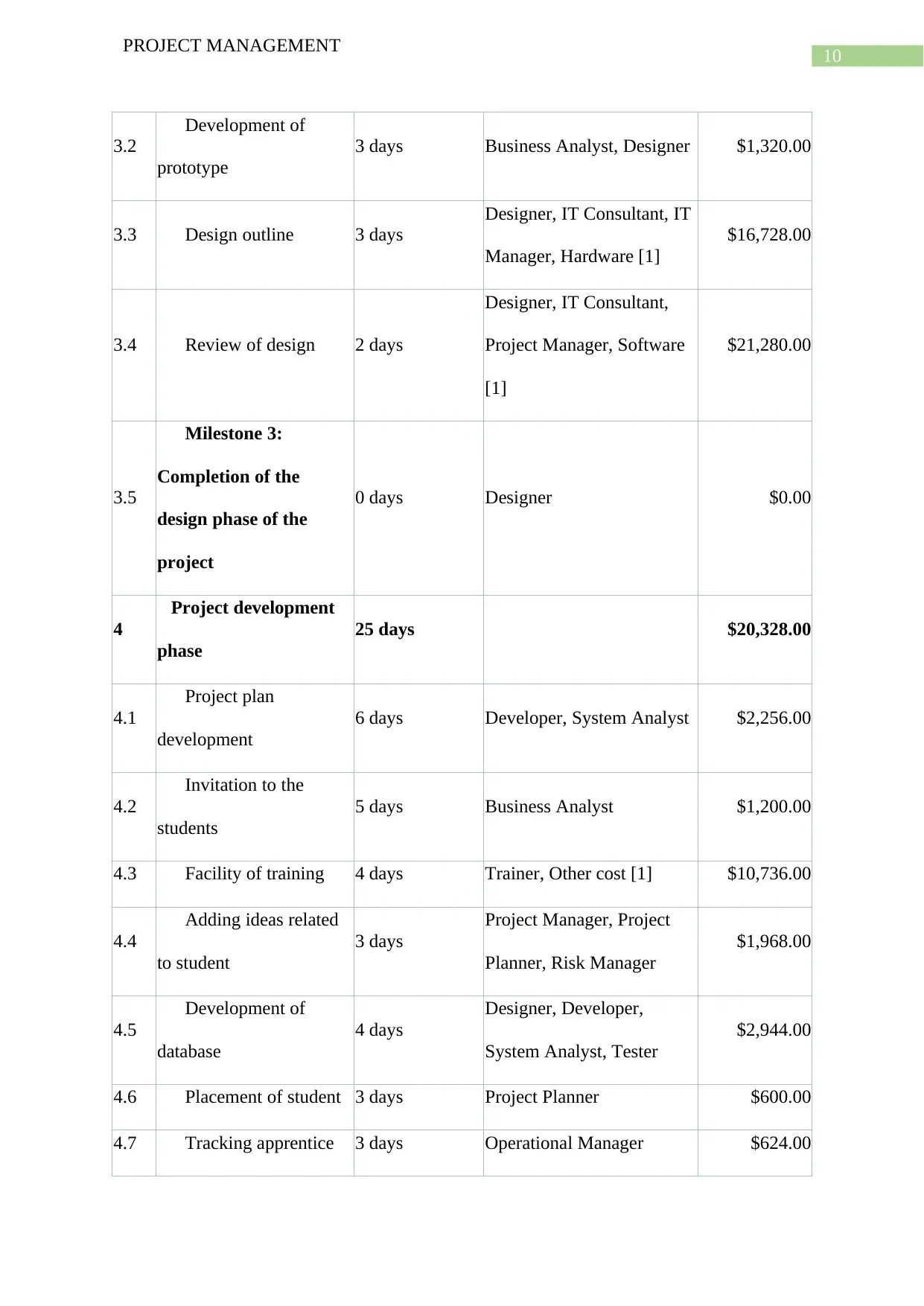
10
PROJECT MANAGEMENT
3.2
Development of
prototype
3 days Business Analyst, Designer $1,320.00
3.3 Design outline 3 days
Designer, IT Consultant, IT
Manager, Hardware [1]
$16,728.00
3.4 Review of design 2 days
Designer, IT Consultant,
Project Manager, Software
[1]
$21,280.00
3.5
Milestone 3:
Completion of the
design phase of the
project
0 days Designer $0.00
4
Project development
phase
25 days $20,328.00
4.1
Project plan
development
6 days Developer, System Analyst $2,256.00
4.2
Invitation to the
students
5 days Business Analyst $1,200.00
4.3 Facility of training 4 days Trainer, Other cost [1] $10,736.00
4.4
Adding ideas related
to student
3 days
Project Manager, Project
Planner, Risk Manager
$1,968.00
4.5
Development of
database
4 days
Designer, Developer,
System Analyst, Tester
$2,944.00
4.6 Placement of student 3 days Project Planner $600.00
4.7 Tracking apprentice 3 days Operational Manager $624.00
PROJECT MANAGEMENT
3.2
Development of
prototype
3 days Business Analyst, Designer $1,320.00
3.3 Design outline 3 days
Designer, IT Consultant, IT
Manager, Hardware [1]
$16,728.00
3.4 Review of design 2 days
Designer, IT Consultant,
Project Manager, Software
[1]
$21,280.00
3.5
Milestone 3:
Completion of the
design phase of the
project
0 days Designer $0.00
4
Project development
phase
25 days $20,328.00
4.1
Project plan
development
6 days Developer, System Analyst $2,256.00
4.2
Invitation to the
students
5 days Business Analyst $1,200.00
4.3 Facility of training 4 days Trainer, Other cost [1] $10,736.00
4.4
Adding ideas related
to student
3 days
Project Manager, Project
Planner, Risk Manager
$1,968.00
4.5
Development of
database
4 days
Designer, Developer,
System Analyst, Tester
$2,944.00
4.6 Placement of student 3 days Project Planner $600.00
4.7 Tracking apprentice 3 days Operational Manager $624.00
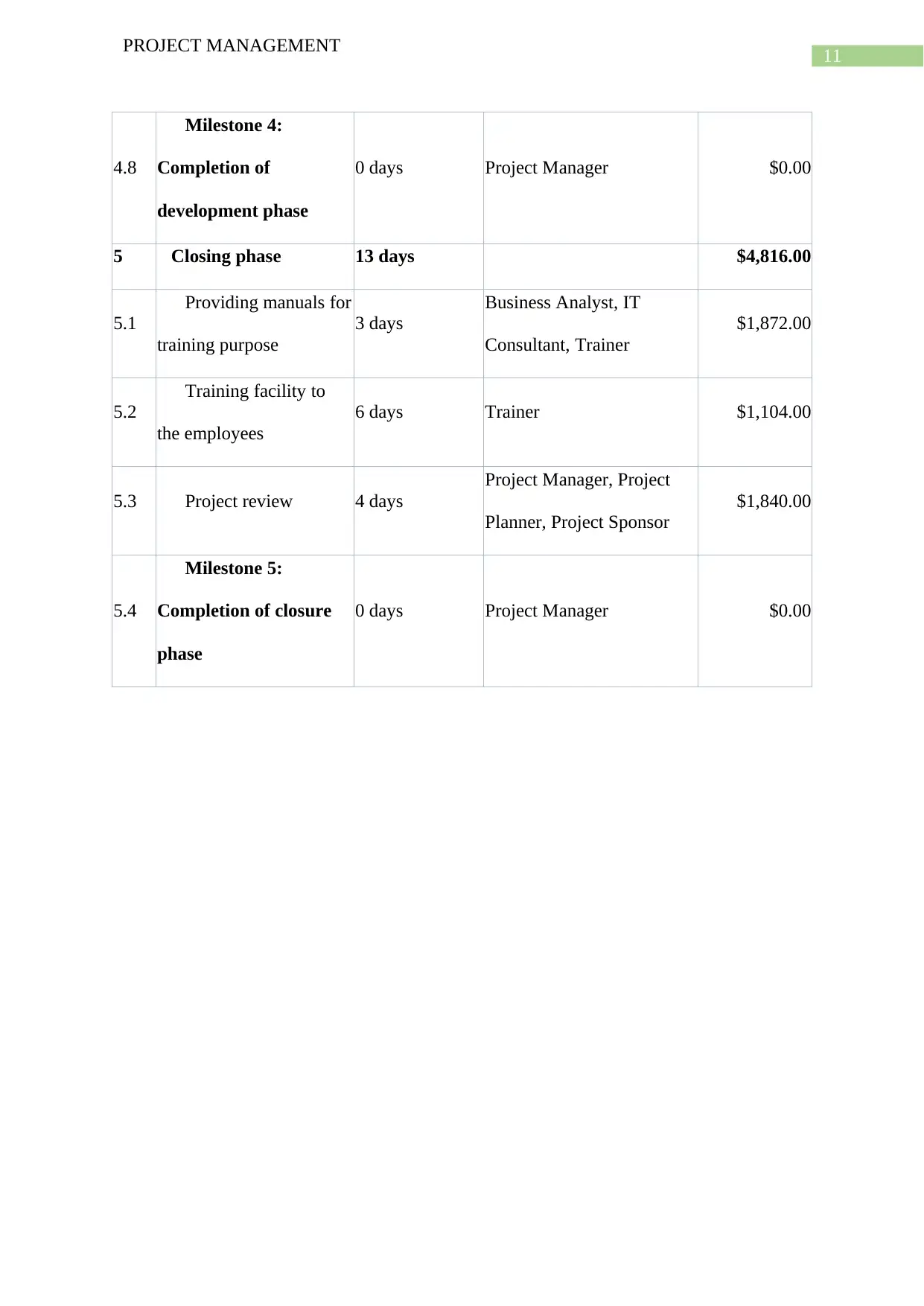
11
PROJECT MANAGEMENT
4.8
Milestone 4:
Completion of
development phase
0 days Project Manager $0.00
5 Closing phase 13 days $4,816.00
5.1
Providing manuals for
training purpose
3 days
Business Analyst, IT
Consultant, Trainer
$1,872.00
5.2
Training facility to
the employees
6 days Trainer $1,104.00
5.3 Project review 4 days
Project Manager, Project
Planner, Project Sponsor
$1,840.00
5.4
Milestone 5:
Completion of closure
phase
0 days Project Manager $0.00
PROJECT MANAGEMENT
4.8
Milestone 4:
Completion of
development phase
0 days Project Manager $0.00
5 Closing phase 13 days $4,816.00
5.1
Providing manuals for
training purpose
3 days
Business Analyst, IT
Consultant, Trainer
$1,872.00
5.2
Training facility to
the employees
6 days Trainer $1,104.00
5.3 Project review 4 days
Project Manager, Project
Planner, Project Sponsor
$1,840.00
5.4
Milestone 5:
Completion of closure
phase
0 days Project Manager $0.00
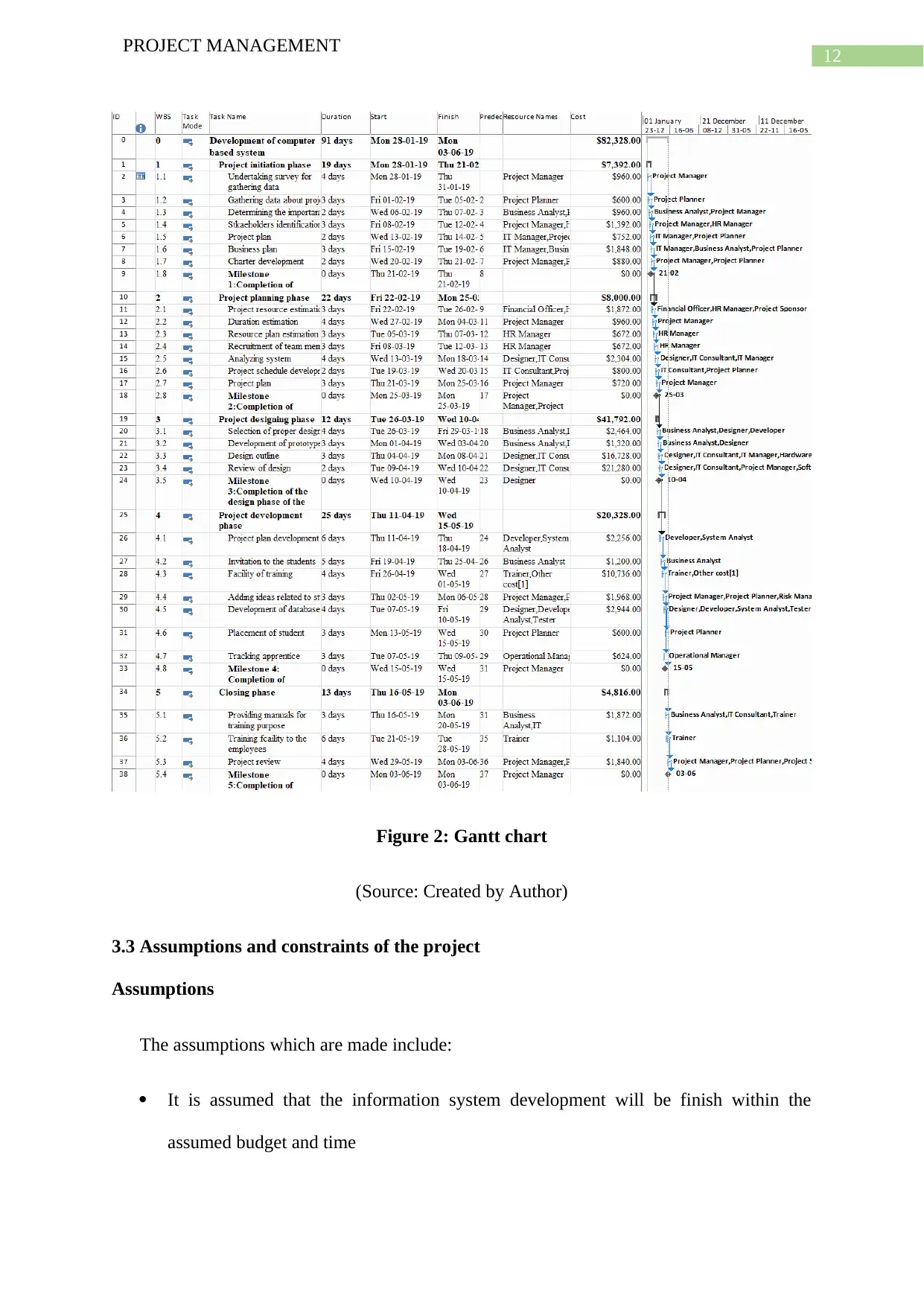
12
PROJECT MANAGEMENT
Figure 2: Gantt chart
(Source: Created by Author)
3.3 Assumptions and constraints of the project
Assumptions
The assumptions which are made include:
It is assumed that the information system development will be finish within the
assumed budget and time
PROJECT MANAGEMENT
Figure 2: Gantt chart
(Source: Created by Author)
3.3 Assumptions and constraints of the project
Assumptions
The assumptions which are made include:
It is assumed that the information system development will be finish within the
assumed budget and time
Paraphrase This Document
Need a fresh take? Get an instant paraphrase of this document with our AI Paraphraser
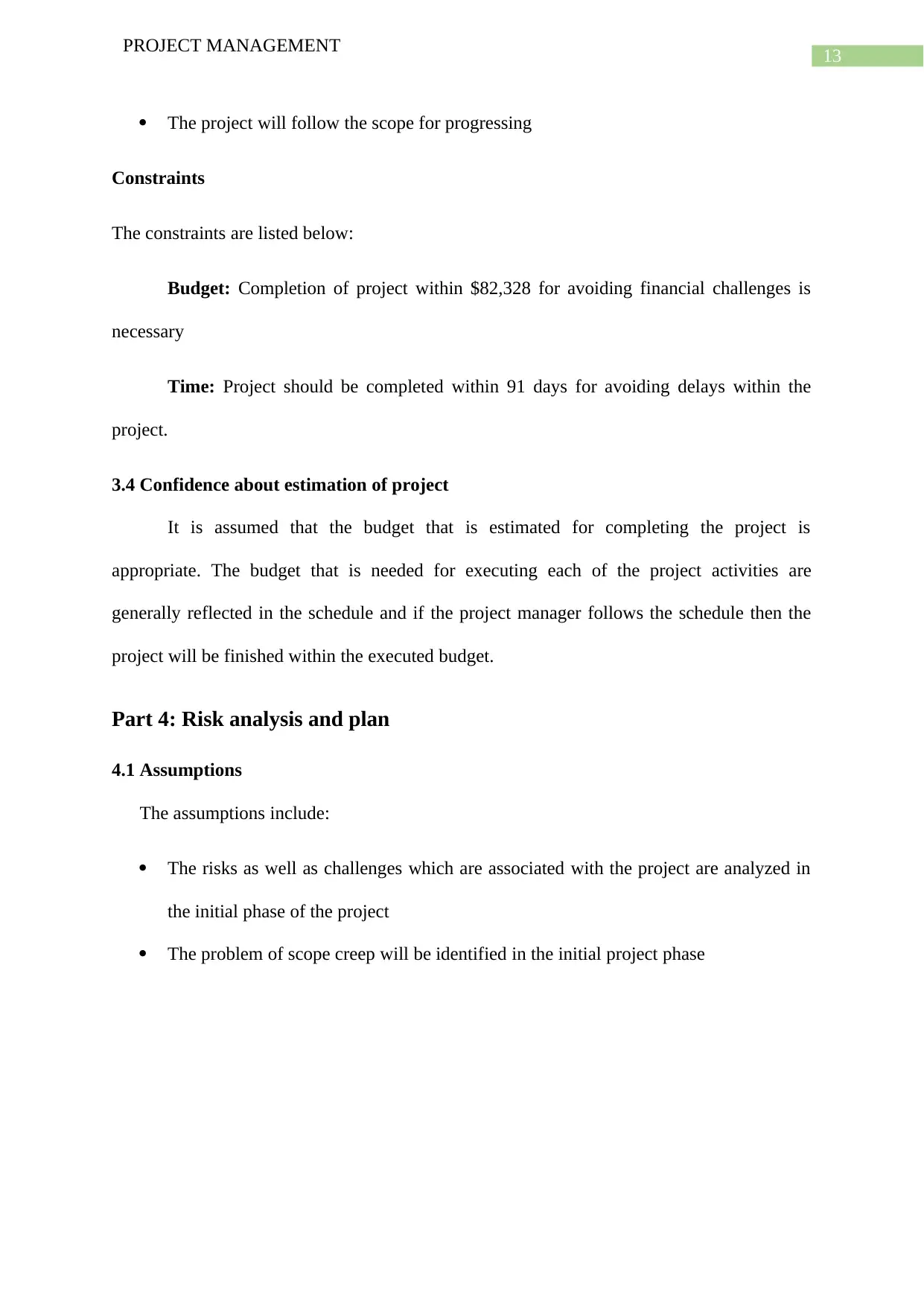
13
PROJECT MANAGEMENT
The project will follow the scope for progressing
Constraints
The constraints are listed below:
Budget: Completion of project within $82,328 for avoiding financial challenges is
necessary
Time: Project should be completed within 91 days for avoiding delays within the
project.
3.4 Confidence about estimation of project
It is assumed that the budget that is estimated for completing the project is
appropriate. The budget that is needed for executing each of the project activities are
generally reflected in the schedule and if the project manager follows the schedule then the
project will be finished within the executed budget.
Part 4: Risk analysis and plan
4.1 Assumptions
The assumptions include:
The risks as well as challenges which are associated with the project are analyzed in
the initial phase of the project
The problem of scope creep will be identified in the initial project phase
PROJECT MANAGEMENT
The project will follow the scope for progressing
Constraints
The constraints are listed below:
Budget: Completion of project within $82,328 for avoiding financial challenges is
necessary
Time: Project should be completed within 91 days for avoiding delays within the
project.
3.4 Confidence about estimation of project
It is assumed that the budget that is estimated for completing the project is
appropriate. The budget that is needed for executing each of the project activities are
generally reflected in the schedule and if the project manager follows the schedule then the
project will be finished within the executed budget.
Part 4: Risk analysis and plan
4.1 Assumptions
The assumptions include:
The risks as well as challenges which are associated with the project are analyzed in
the initial phase of the project
The problem of scope creep will be identified in the initial project phase
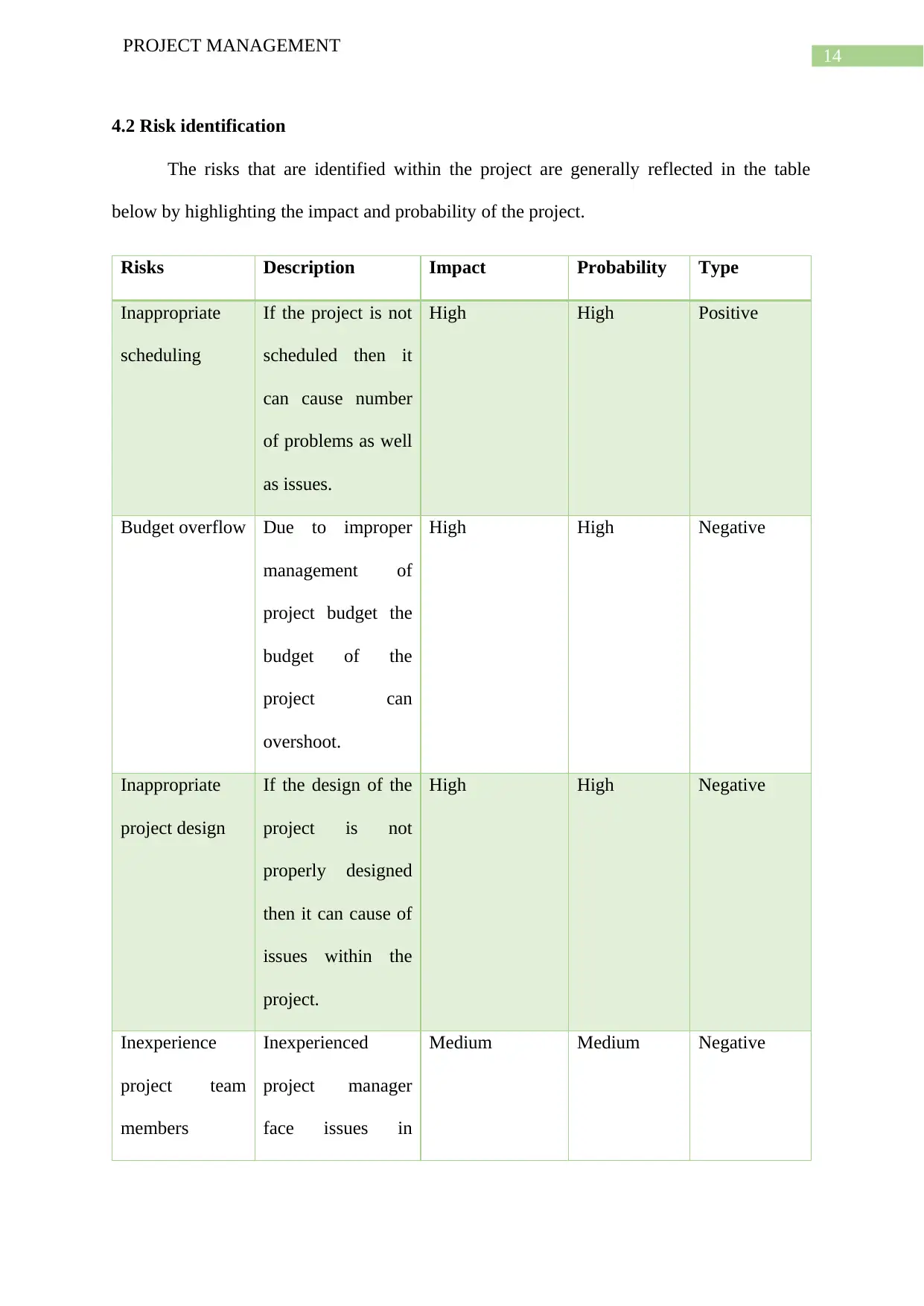
14
PROJECT MANAGEMENT
4.2 Risk identification
The risks that are identified within the project are generally reflected in the table
below by highlighting the impact and probability of the project.
Risks Description Impact Probability Type
Inappropriate
scheduling
If the project is not
scheduled then it
can cause number
of problems as well
as issues.
High High Positive
Budget overflow Due to improper
management of
project budget the
budget of the
project can
overshoot.
High High Negative
Inappropriate
project design
If the design of the
project is not
properly designed
then it can cause of
issues within the
project.
High High Negative
Inexperience
project team
members
Inexperienced
project manager
face issues in
Medium Medium Negative
PROJECT MANAGEMENT
4.2 Risk identification
The risks that are identified within the project are generally reflected in the table
below by highlighting the impact and probability of the project.
Risks Description Impact Probability Type
Inappropriate
scheduling
If the project is not
scheduled then it
can cause number
of problems as well
as issues.
High High Positive
Budget overflow Due to improper
management of
project budget the
budget of the
project can
overshoot.
High High Negative
Inappropriate
project design
If the design of the
project is not
properly designed
then it can cause of
issues within the
project.
High High Negative
Inexperience
project team
members
Inexperienced
project manager
face issues in
Medium Medium Negative
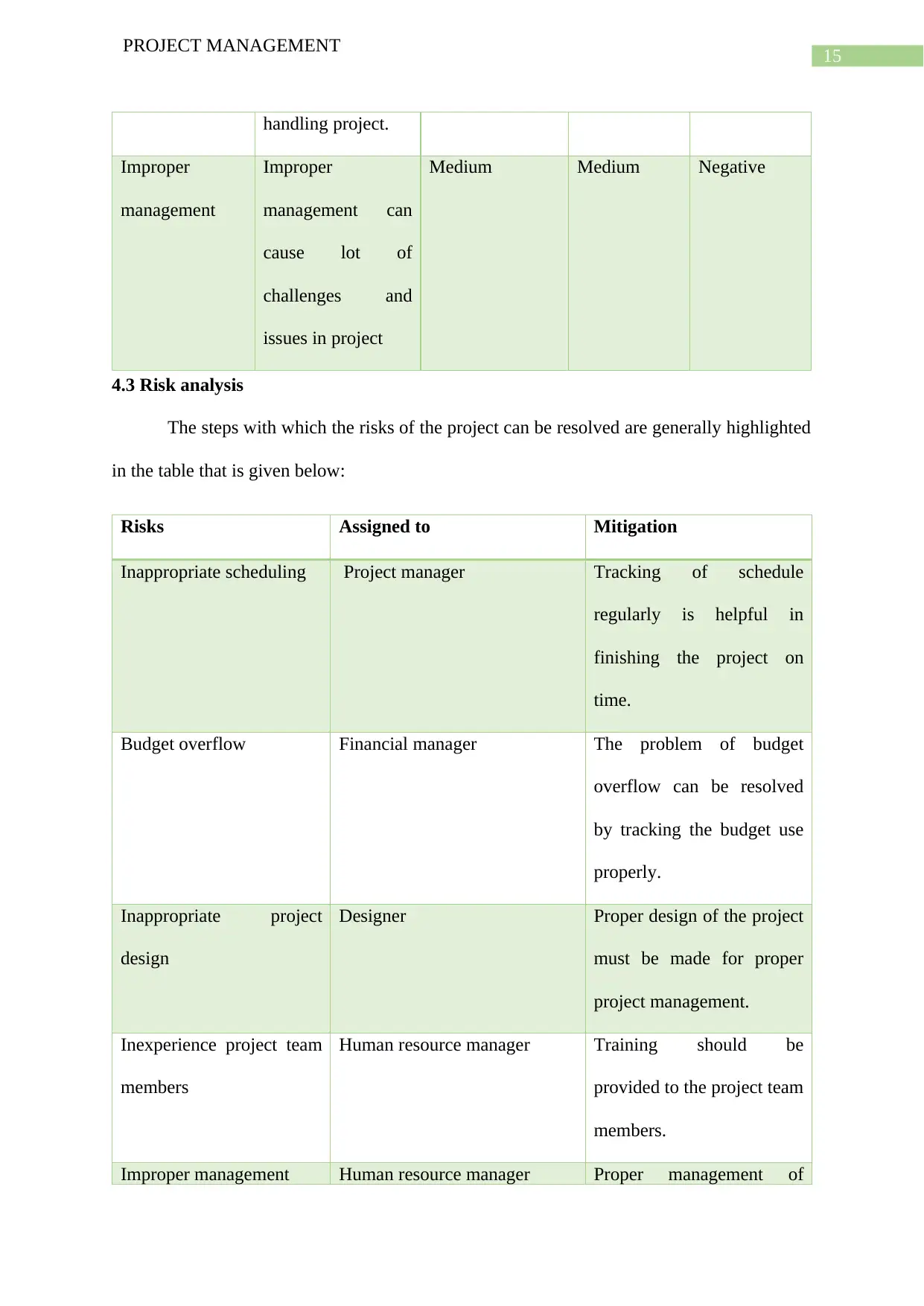
15
PROJECT MANAGEMENT
handling project.
Improper
management
Improper
management can
cause lot of
challenges and
issues in project
Medium Medium Negative
4.3 Risk analysis
The steps with which the risks of the project can be resolved are generally highlighted
in the table that is given below:
Risks Assigned to Mitigation
Inappropriate scheduling Project manager Tracking of schedule
regularly is helpful in
finishing the project on
time.
Budget overflow Financial manager The problem of budget
overflow can be resolved
by tracking the budget use
properly.
Inappropriate project
design
Designer Proper design of the project
must be made for proper
project management.
Inexperience project team
members
Human resource manager Training should be
provided to the project team
members.
Improper management Human resource manager Proper management of
PROJECT MANAGEMENT
handling project.
Improper
management
Improper
management can
cause lot of
challenges and
issues in project
Medium Medium Negative
4.3 Risk analysis
The steps with which the risks of the project can be resolved are generally highlighted
in the table that is given below:
Risks Assigned to Mitigation
Inappropriate scheduling Project manager Tracking of schedule
regularly is helpful in
finishing the project on
time.
Budget overflow Financial manager The problem of budget
overflow can be resolved
by tracking the budget use
properly.
Inappropriate project
design
Designer Proper design of the project
must be made for proper
project management.
Inexperience project team
members
Human resource manager Training should be
provided to the project team
members.
Improper management Human resource manager Proper management of
Secure Best Marks with AI Grader
Need help grading? Try our AI Grader for instant feedback on your assignments.
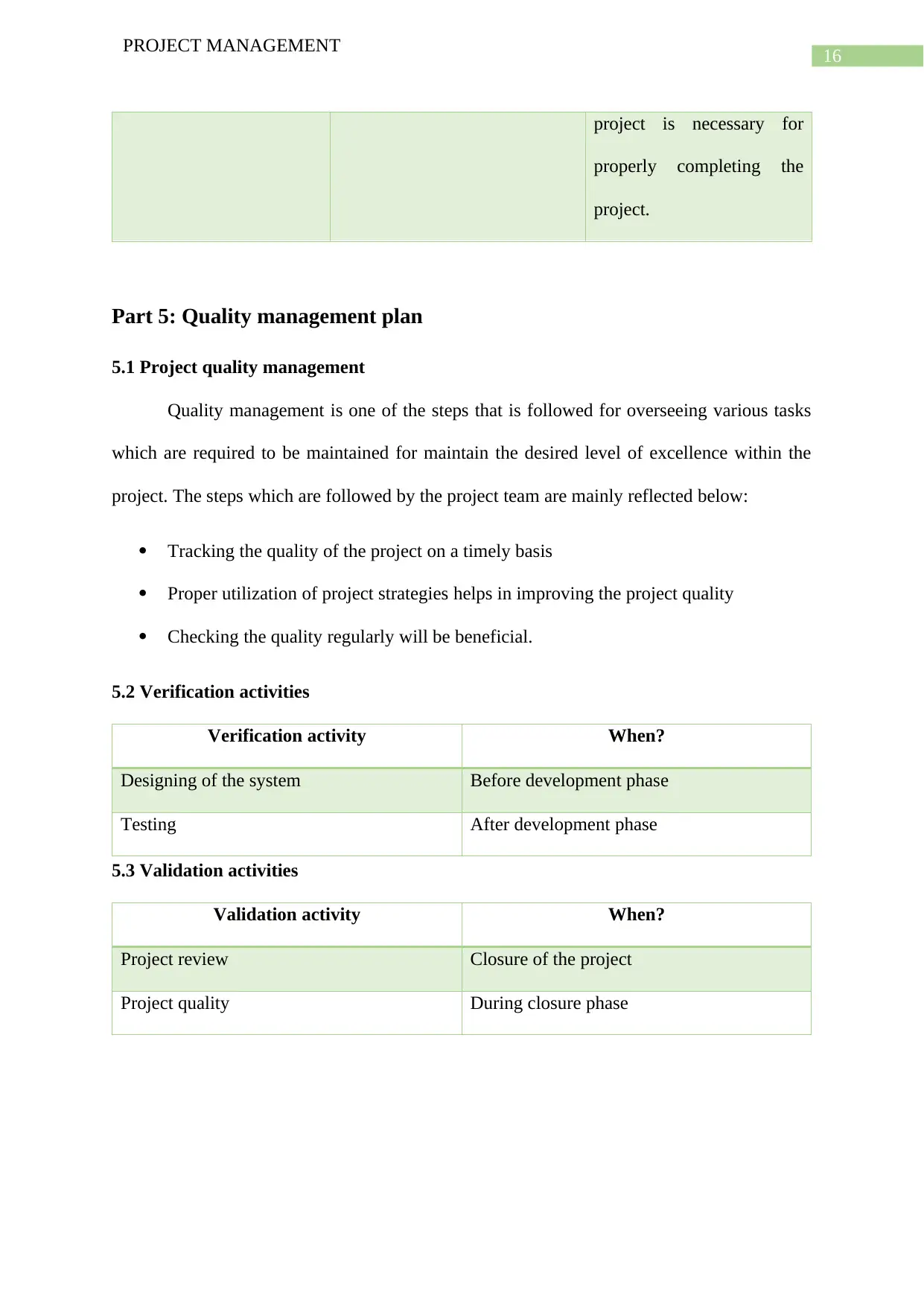
16
PROJECT MANAGEMENT
project is necessary for
properly completing the
project.
Part 5: Quality management plan
5.1 Project quality management
Quality management is one of the steps that is followed for overseeing various tasks
which are required to be maintained for maintain the desired level of excellence within the
project. The steps which are followed by the project team are mainly reflected below:
Tracking the quality of the project on a timely basis
Proper utilization of project strategies helps in improving the project quality
Checking the quality regularly will be beneficial.
5.2 Verification activities
Verification activity When?
Designing of the system Before development phase
Testing After development phase
5.3 Validation activities
Validation activity When?
Project review Closure of the project
Project quality During closure phase
PROJECT MANAGEMENT
project is necessary for
properly completing the
project.
Part 5: Quality management plan
5.1 Project quality management
Quality management is one of the steps that is followed for overseeing various tasks
which are required to be maintained for maintain the desired level of excellence within the
project. The steps which are followed by the project team are mainly reflected below:
Tracking the quality of the project on a timely basis
Proper utilization of project strategies helps in improving the project quality
Checking the quality regularly will be beneficial.
5.2 Verification activities
Verification activity When?
Designing of the system Before development phase
Testing After development phase
5.3 Validation activities
Validation activity When?
Project review Closure of the project
Project quality During closure phase
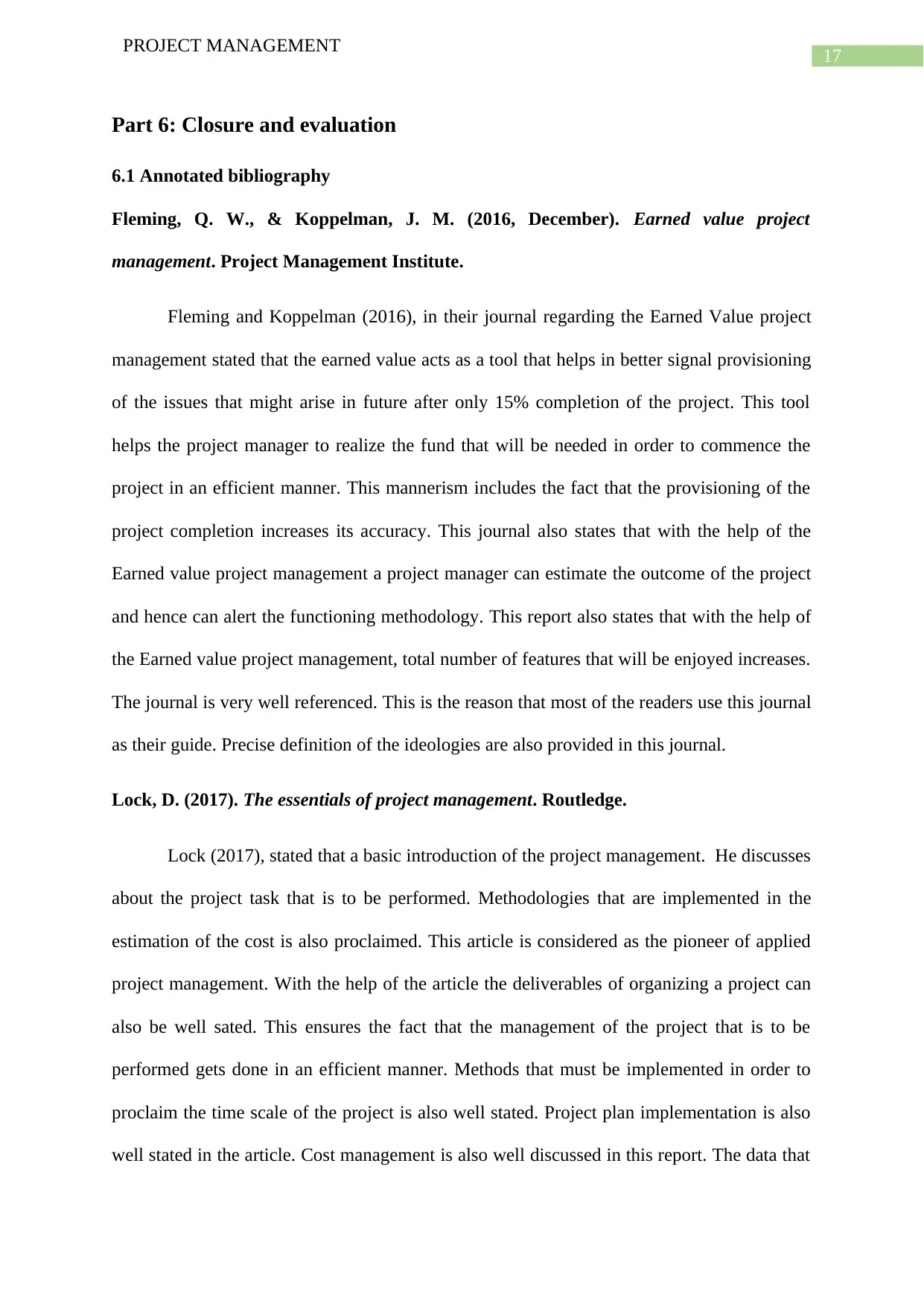
17
PROJECT MANAGEMENT
Part 6: Closure and evaluation
6.1 Annotated bibliography
Fleming, Q. W., & Koppelman, J. M. (2016, December). Earned value project
management. Project Management Institute.
Fleming and Koppelman (2016), in their journal regarding the Earned Value project
management stated that the earned value acts as a tool that helps in better signal provisioning
of the issues that might arise in future after only 15% completion of the project. This tool
helps the project manager to realize the fund that will be needed in order to commence the
project in an efficient manner. This mannerism includes the fact that the provisioning of the
project completion increases its accuracy. This journal also states that with the help of the
Earned value project management a project manager can estimate the outcome of the project
and hence can alert the functioning methodology. This report also states that with the help of
the Earned value project management, total number of features that will be enjoyed increases.
The journal is very well referenced. This is the reason that most of the readers use this journal
as their guide. Precise definition of the ideologies are also provided in this journal.
Lock, D. (2017). The essentials of project management. Routledge.
Lock (2017), stated that a basic introduction of the project management. He discusses
about the project task that is to be performed. Methodologies that are implemented in the
estimation of the cost is also proclaimed. This article is considered as the pioneer of applied
project management. With the help of the article the deliverables of organizing a project can
also be well sated. This ensures the fact that the management of the project that is to be
performed gets done in an efficient manner. Methods that must be implemented in order to
proclaim the time scale of the project is also well stated. Project plan implementation is also
well stated in the article. Cost management is also well discussed in this report. The data that
PROJECT MANAGEMENT
Part 6: Closure and evaluation
6.1 Annotated bibliography
Fleming, Q. W., & Koppelman, J. M. (2016, December). Earned value project
management. Project Management Institute.
Fleming and Koppelman (2016), in their journal regarding the Earned Value project
management stated that the earned value acts as a tool that helps in better signal provisioning
of the issues that might arise in future after only 15% completion of the project. This tool
helps the project manager to realize the fund that will be needed in order to commence the
project in an efficient manner. This mannerism includes the fact that the provisioning of the
project completion increases its accuracy. This journal also states that with the help of the
Earned value project management a project manager can estimate the outcome of the project
and hence can alert the functioning methodology. This report also states that with the help of
the Earned value project management, total number of features that will be enjoyed increases.
The journal is very well referenced. This is the reason that most of the readers use this journal
as their guide. Precise definition of the ideologies are also provided in this journal.
Lock, D. (2017). The essentials of project management. Routledge.
Lock (2017), stated that a basic introduction of the project management. He discusses
about the project task that is to be performed. Methodologies that are implemented in the
estimation of the cost is also proclaimed. This article is considered as the pioneer of applied
project management. With the help of the article the deliverables of organizing a project can
also be well sated. This ensures the fact that the management of the project that is to be
performed gets done in an efficient manner. Methods that must be implemented in order to
proclaim the time scale of the project is also well stated. Project plan implementation is also
well stated in the article. Cost management is also well discussed in this report. The data that
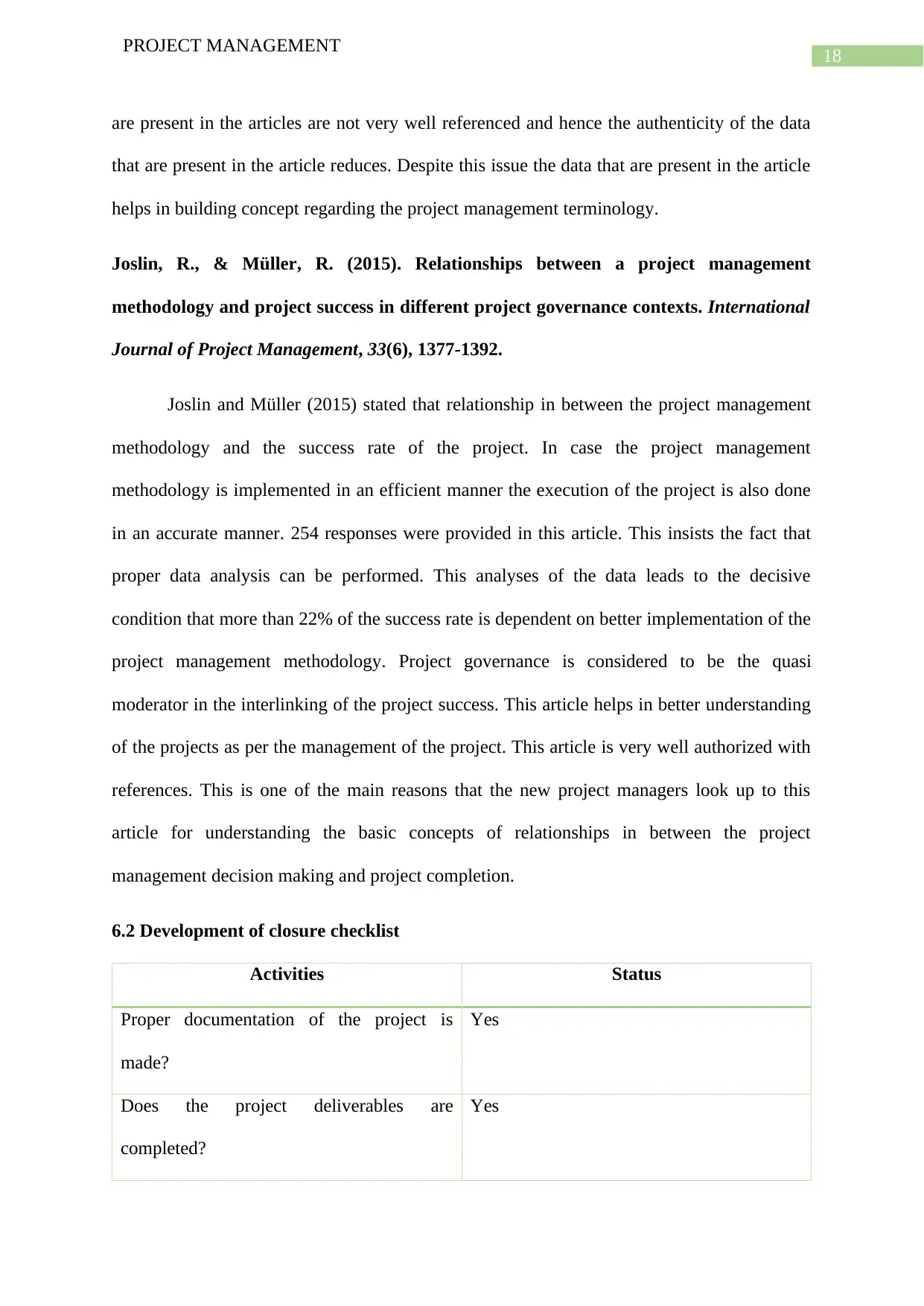
18
PROJECT MANAGEMENT
are present in the articles are not very well referenced and hence the authenticity of the data
that are present in the article reduces. Despite this issue the data that are present in the article
helps in building concept regarding the project management terminology.
Joslin, R., & Müller, R. (2015). Relationships between a project management
methodology and project success in different project governance contexts. International
Journal of Project Management, 33(6), 1377-1392.
Joslin and Müller (2015) stated that relationship in between the project management
methodology and the success rate of the project. In case the project management
methodology is implemented in an efficient manner the execution of the project is also done
in an accurate manner. 254 responses were provided in this article. This insists the fact that
proper data analysis can be performed. This analyses of the data leads to the decisive
condition that more than 22% of the success rate is dependent on better implementation of the
project management methodology. Project governance is considered to be the quasi
moderator in the interlinking of the project success. This article helps in better understanding
of the projects as per the management of the project. This article is very well authorized with
references. This is one of the main reasons that the new project managers look up to this
article for understanding the basic concepts of relationships in between the project
management decision making and project completion.
6.2 Development of closure checklist
Activities Status
Proper documentation of the project is
made?
Yes
Does the project deliverables are
completed?
Yes
PROJECT MANAGEMENT
are present in the articles are not very well referenced and hence the authenticity of the data
that are present in the article reduces. Despite this issue the data that are present in the article
helps in building concept regarding the project management terminology.
Joslin, R., & Müller, R. (2015). Relationships between a project management
methodology and project success in different project governance contexts. International
Journal of Project Management, 33(6), 1377-1392.
Joslin and Müller (2015) stated that relationship in between the project management
methodology and the success rate of the project. In case the project management
methodology is implemented in an efficient manner the execution of the project is also done
in an accurate manner. 254 responses were provided in this article. This insists the fact that
proper data analysis can be performed. This analyses of the data leads to the decisive
condition that more than 22% of the success rate is dependent on better implementation of the
project management methodology. Project governance is considered to be the quasi
moderator in the interlinking of the project success. This article helps in better understanding
of the projects as per the management of the project. This article is very well authorized with
references. This is one of the main reasons that the new project managers look up to this
article for understanding the basic concepts of relationships in between the project
management decision making and project completion.
6.2 Development of closure checklist
Activities Status
Proper documentation of the project is
made?
Yes
Does the project deliverables are
completed?
Yes
Paraphrase This Document
Need a fresh take? Get an instant paraphrase of this document with our AI Paraphraser
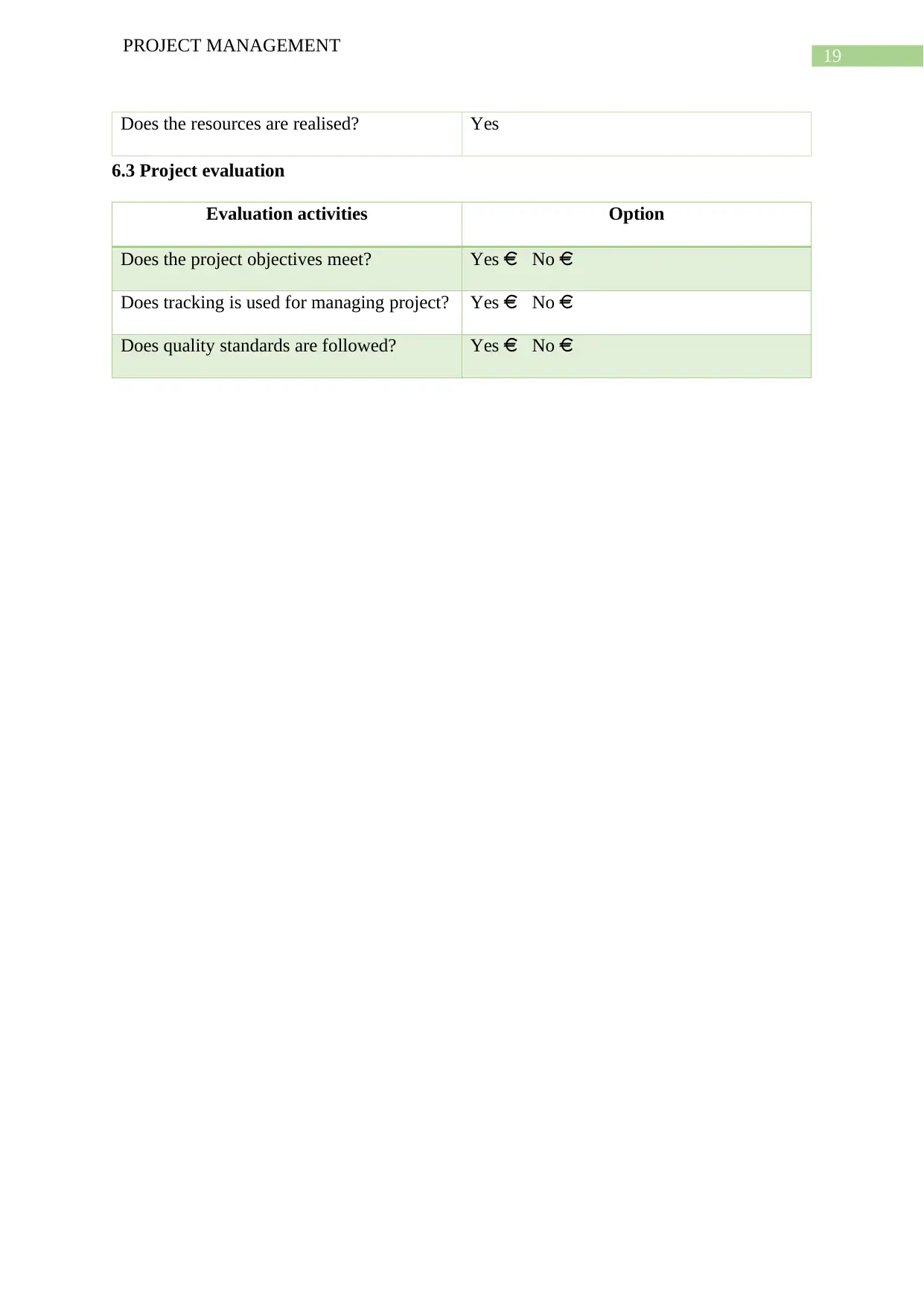
19
PROJECT MANAGEMENT
Does the resources are realised? Yes
6.3 Project evaluation
Evaluation activities Option
Does the project objectives meet? Yes No
Does tracking is used for managing project? Yes No
Does quality standards are followed? Yes No
PROJECT MANAGEMENT
Does the resources are realised? Yes
6.3 Project evaluation
Evaluation activities Option
Does the project objectives meet? Yes No
Does tracking is used for managing project? Yes No
Does quality standards are followed? Yes No
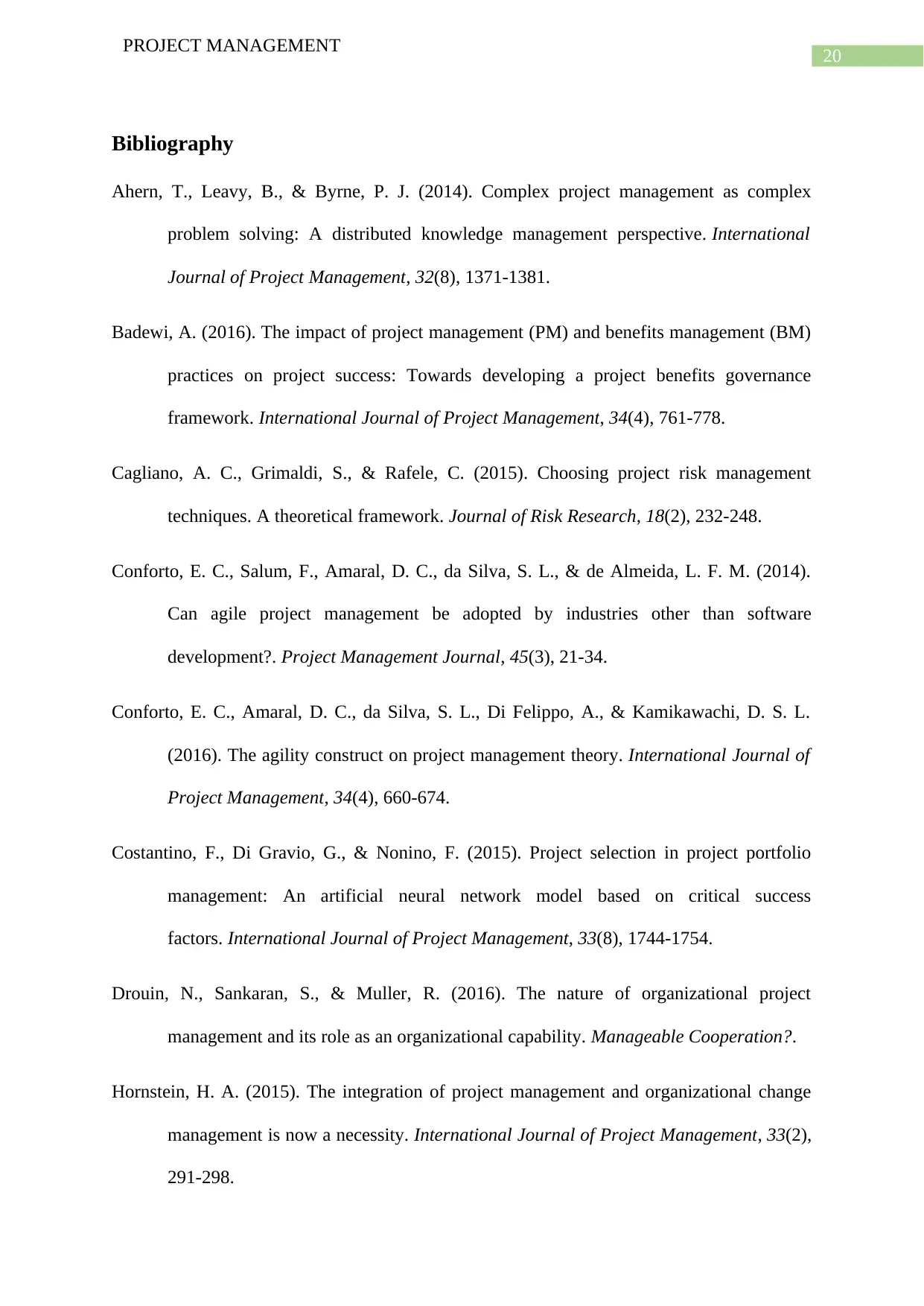
20
PROJECT MANAGEMENT
Bibliography
Ahern, T., Leavy, B., & Byrne, P. J. (2014). Complex project management as complex
problem solving: A distributed knowledge management perspective. International
Journal of Project Management, 32(8), 1371-1381.
Badewi, A. (2016). The impact of project management (PM) and benefits management (BM)
practices on project success: Towards developing a project benefits governance
framework. International Journal of Project Management, 34(4), 761-778.
Cagliano, A. C., Grimaldi, S., & Rafele, C. (2015). Choosing project risk management
techniques. A theoretical framework. Journal of Risk Research, 18(2), 232-248.
Conforto, E. C., Salum, F., Amaral, D. C., da Silva, S. L., & de Almeida, L. F. M. (2014).
Can agile project management be adopted by industries other than software
development?. Project Management Journal, 45(3), 21-34.
Conforto, E. C., Amaral, D. C., da Silva, S. L., Di Felippo, A., & Kamikawachi, D. S. L.
(2016). The agility construct on project management theory. International Journal of
Project Management, 34(4), 660-674.
Costantino, F., Di Gravio, G., & Nonino, F. (2015). Project selection in project portfolio
management: An artificial neural network model based on critical success
factors. International Journal of Project Management, 33(8), 1744-1754.
Drouin, N., Sankaran, S., & Muller, R. (2016). The nature of organizational project
management and its role as an organizational capability. Manageable Cooperation?.
Hornstein, H. A. (2015). The integration of project management and organizational change
management is now a necessity. International Journal of Project Management, 33(2),
291-298.
PROJECT MANAGEMENT
Bibliography
Ahern, T., Leavy, B., & Byrne, P. J. (2014). Complex project management as complex
problem solving: A distributed knowledge management perspective. International
Journal of Project Management, 32(8), 1371-1381.
Badewi, A. (2016). The impact of project management (PM) and benefits management (BM)
practices on project success: Towards developing a project benefits governance
framework. International Journal of Project Management, 34(4), 761-778.
Cagliano, A. C., Grimaldi, S., & Rafele, C. (2015). Choosing project risk management
techniques. A theoretical framework. Journal of Risk Research, 18(2), 232-248.
Conforto, E. C., Salum, F., Amaral, D. C., da Silva, S. L., & de Almeida, L. F. M. (2014).
Can agile project management be adopted by industries other than software
development?. Project Management Journal, 45(3), 21-34.
Conforto, E. C., Amaral, D. C., da Silva, S. L., Di Felippo, A., & Kamikawachi, D. S. L.
(2016). The agility construct on project management theory. International Journal of
Project Management, 34(4), 660-674.
Costantino, F., Di Gravio, G., & Nonino, F. (2015). Project selection in project portfolio
management: An artificial neural network model based on critical success
factors. International Journal of Project Management, 33(8), 1744-1754.
Drouin, N., Sankaran, S., & Muller, R. (2016). The nature of organizational project
management and its role as an organizational capability. Manageable Cooperation?.
Hornstein, H. A. (2015). The integration of project management and organizational change
management is now a necessity. International Journal of Project Management, 33(2),
291-298.

21
PROJECT MANAGEMENT
Joslin, R., & Müller, R. (2015). Relationships between a project management methodology
and project success in different project governance contexts. International Journal of
Project Management, 33(6), 1377-1392.
Kaiser, M. G., El Arbi, F., & Ahlemann, F. (2015). Successful project portfolio management
beyond project selection techniques: Understanding the role of structural
alignment. International Journal of Project Management, 33(1), 126-139.
Kerzner, H. (2017). Project management metrics, KPIs, and dashboards: a guide to
measuring and monitoring project performance. John Wiley & Sons.
Kucharska, W., & Kowalczyk, R. (2016). Trust, collaborative culture and tacit knowledge
sharing in project management–A relationship model.
Marcelino-Sádaba, S., Pérez-Ezcurdia, A., Lazcano, A. M. E., & Villanueva, P. (2014).
Project risk management methodology for small firms. International journal of
project management, 32(2), 327-340.
Sánchez, M. A. (2015). Integrating sustainability issues into project management. Journal of
Cleaner Production, 96, 319-330.
Serra, C. E. M., & Kunc, M. (2015). Benefits realisation management and its influence on
project success and on the execution of business strategies. International Journal of
Project Management, 33(1), 53-66.
Svejvig, P., & Andersen, P. (2015). Rethinking project management: A structured literature
review with a critical look at the brave new world. International Journal of Project
Management, 33(2), 278-290.
PROJECT MANAGEMENT
Joslin, R., & Müller, R. (2015). Relationships between a project management methodology
and project success in different project governance contexts. International Journal of
Project Management, 33(6), 1377-1392.
Kaiser, M. G., El Arbi, F., & Ahlemann, F. (2015). Successful project portfolio management
beyond project selection techniques: Understanding the role of structural
alignment. International Journal of Project Management, 33(1), 126-139.
Kerzner, H. (2017). Project management metrics, KPIs, and dashboards: a guide to
measuring and monitoring project performance. John Wiley & Sons.
Kucharska, W., & Kowalczyk, R. (2016). Trust, collaborative culture and tacit knowledge
sharing in project management–A relationship model.
Marcelino-Sádaba, S., Pérez-Ezcurdia, A., Lazcano, A. M. E., & Villanueva, P. (2014).
Project risk management methodology for small firms. International journal of
project management, 32(2), 327-340.
Sánchez, M. A. (2015). Integrating sustainability issues into project management. Journal of
Cleaner Production, 96, 319-330.
Serra, C. E. M., & Kunc, M. (2015). Benefits realisation management and its influence on
project success and on the execution of business strategies. International Journal of
Project Management, 33(1), 53-66.
Svejvig, P., & Andersen, P. (2015). Rethinking project management: A structured literature
review with a critical look at the brave new world. International Journal of Project
Management, 33(2), 278-290.
Secure Best Marks with AI Grader
Need help grading? Try our AI Grader for instant feedback on your assignments.
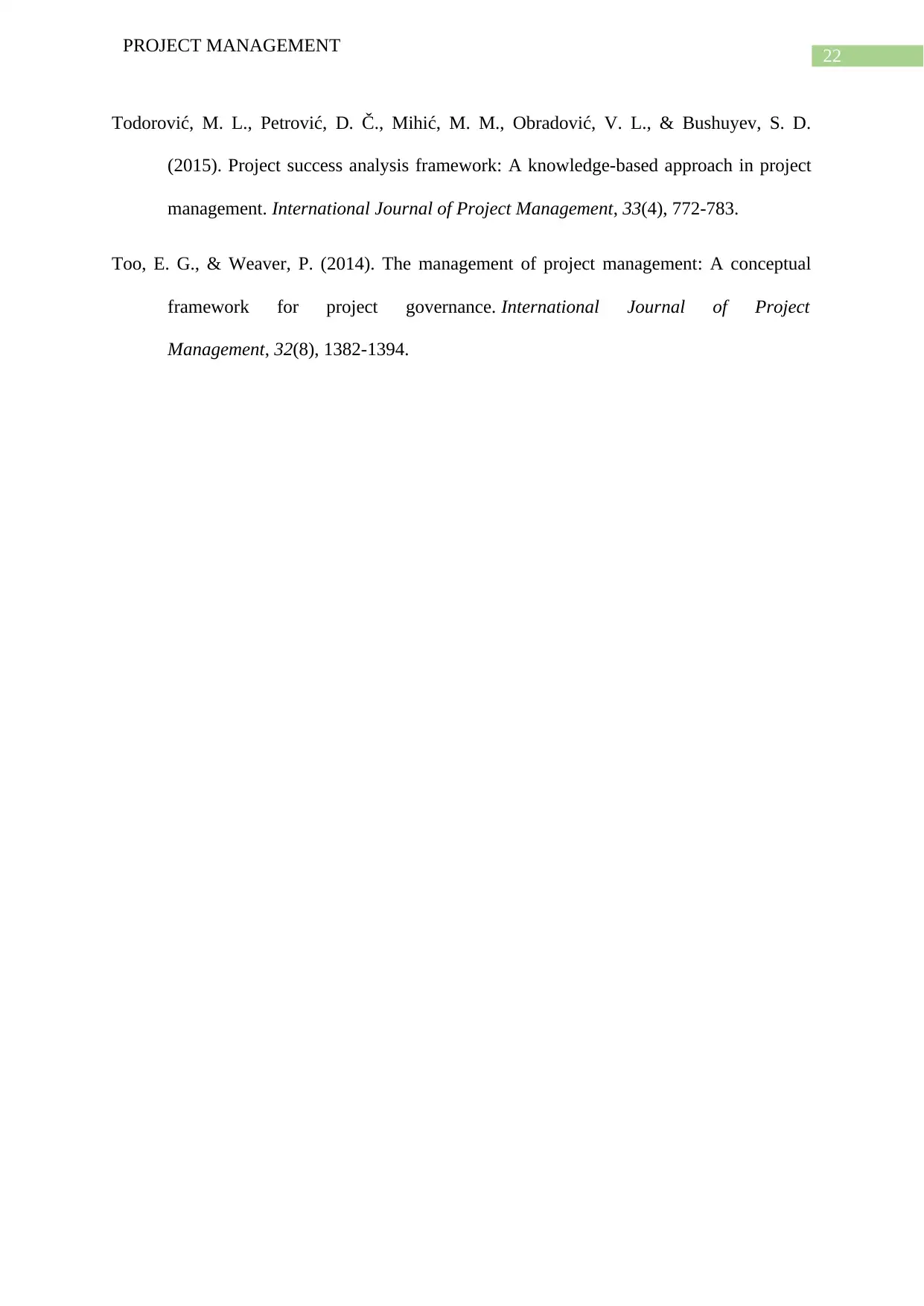
22
PROJECT MANAGEMENT
Todorović, M. L., Petrović, D. Č., Mihić, M. M., Obradović, V. L., & Bushuyev, S. D.
(2015). Project success analysis framework: A knowledge-based approach in project
management. International Journal of Project Management, 33(4), 772-783.
Too, E. G., & Weaver, P. (2014). The management of project management: A conceptual
framework for project governance. International Journal of Project
Management, 32(8), 1382-1394.
PROJECT MANAGEMENT
Todorović, M. L., Petrović, D. Č., Mihić, M. M., Obradović, V. L., & Bushuyev, S. D.
(2015). Project success analysis framework: A knowledge-based approach in project
management. International Journal of Project Management, 33(4), 772-783.
Too, E. G., & Weaver, P. (2014). The management of project management: A conceptual
framework for project governance. International Journal of Project
Management, 32(8), 1382-1394.
1 out of 23
Related Documents
Your All-in-One AI-Powered Toolkit for Academic Success.
+13062052269
info@desklib.com
Available 24*7 on WhatsApp / Email
![[object Object]](/_next/static/media/star-bottom.7253800d.svg)
Unlock your academic potential
© 2024 | Zucol Services PVT LTD | All rights reserved.





